Poetic Yunnan 10: Three poems on Lancang Ferry
The Lancang-Mekong River has linked China to five ASEAN countries since ancient times, and the Lancang Ferry between west Yunnan’s Dali and Baoshan has been a key stop on the Southern Silk Road. For the Eighth Greater Mekong Subregion Summit in Yunnan earlier this month, let’s get to know three classic Yunnan poems that recorded the ancient thoughts, scenic beauty and travel experience at the Lancang Ferry.
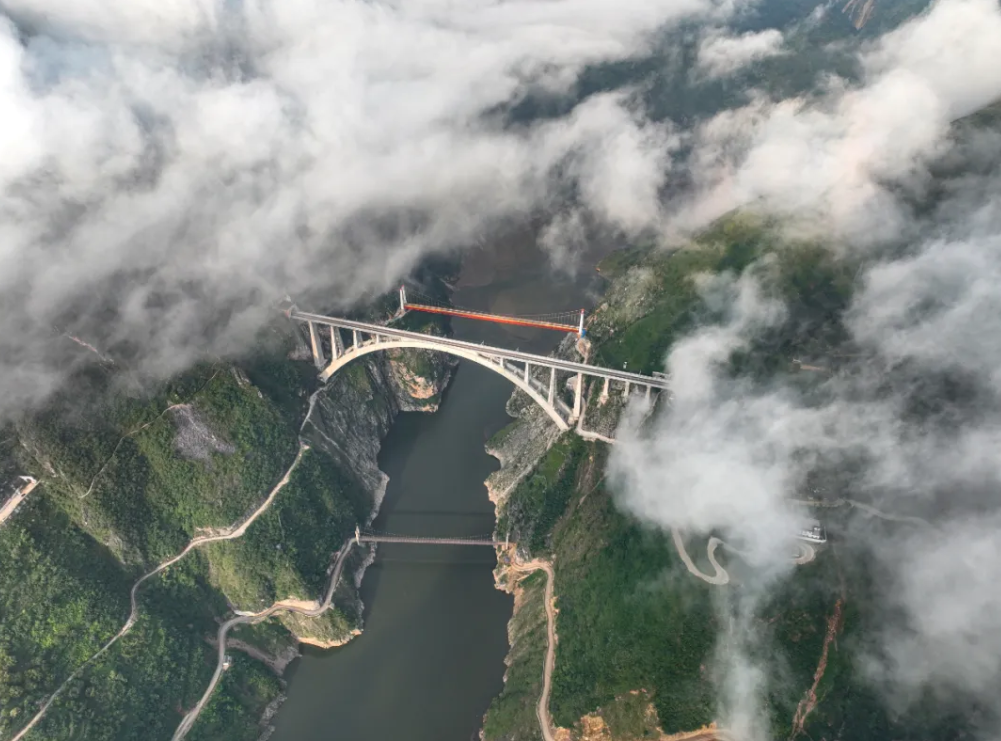
A current view of the Lancang Ferry between west Yunnan’s Dali and Baoshan
I
dù lán cāng gē
渡兰沧歌
hàn dé guǎng
汉德广,
kāi bù bīn
开不宾。
dù bó nán
度博南,
yuè lán jīn
越兰津。
dù lán cāng
渡兰沧,
wéi tā rén
为他人。
Crossing Lancang River
--A Han ballad
Great Han kindness
Guides the tameless.
We scale Mt. Bonan,
Reaching Ferry Lan.
We cross the river
To benefit the other.
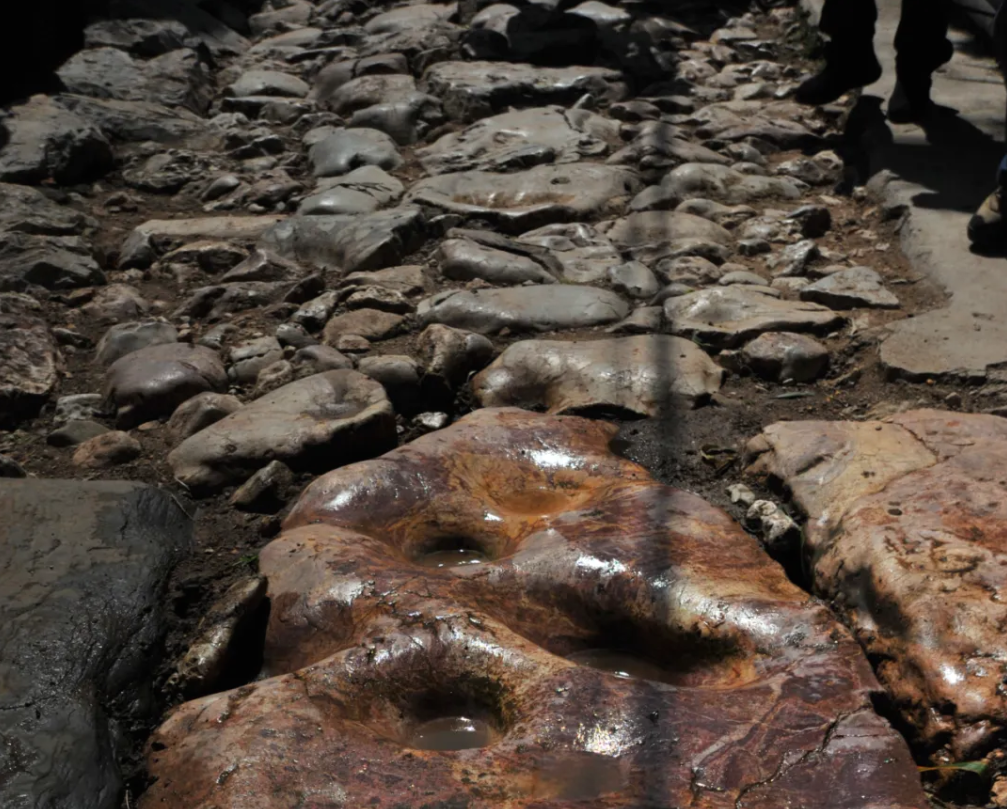
A section of the ancient Southern Silk Road in west Yunnan’s Baoshan
Culture ABCs:
a.This poem is one of the earliest Yunnan ballads recorded in ancient documents. When Yongchang, today’s Baoshan, was established as a county during the reign of Emperor Ming (57-75AD) in the Eastern Han Dynasty, the Bonan Mountain and the Lancang River began to be accessed by the central government, and the travelers sang this ballad to ease their fatigue from a long journey. Critics commented: "Plain in style but rich in meaning, the ancient ballad is better than most of its peers by later generations, and it indeed has the flavor of songs by the Music Bureau of the Han Dynasty." Before reading the ballad, we need to note that 兰沧/lán cāng in the title and Line 5 is the ancient name of the current 澜沧, though the pronunciation is the same.
b. 博南/bó nán in Line 3 refers to the Bonan Mountain in Yongping county, west Yunnan’s Dali prefecture. Standing right on the eastern bank of the Lancang River, Mt. Bonan is a must pass on the Southern Silk Road, with some ancient-trade remains still traceable today.
c. 兰津/lán jīn in Line 4 refers to the Lancang Ferry, where the ancient “兰” is an equivalent to “澜” in today’s vocabulary. Back in the Han Dynasty, only bamboo rafts were available at the ferry, and there was no permanent bridge over the river.
II
lán jīn dù
兰津渡
zhāng hán
张含
shān xíng wǎn bào āi láo guó
山形宛抱哀牢国,
qiān yá wàn hè shēng sōng fēng
千崖万壑生松风。
shí luò zhēn cóng hàn zhū gé
石落真从汉诸葛,
tiě zhù huò chuán táng è gōng
铁柱或传唐鄂公。
qiáo tōng chì xiāo fǔ bì mǎ
桥通赤霄俯碧马,
jiāng hán zǐ yān fú bái lóng
江含紫烟浮白龙。
yú liáng què jià dé yǒu cǐ
鱼梁鹊架得有此,
jué dǐng zhǐ chǐ fán tóng gōng
绝顶咫尺樊桐宫。
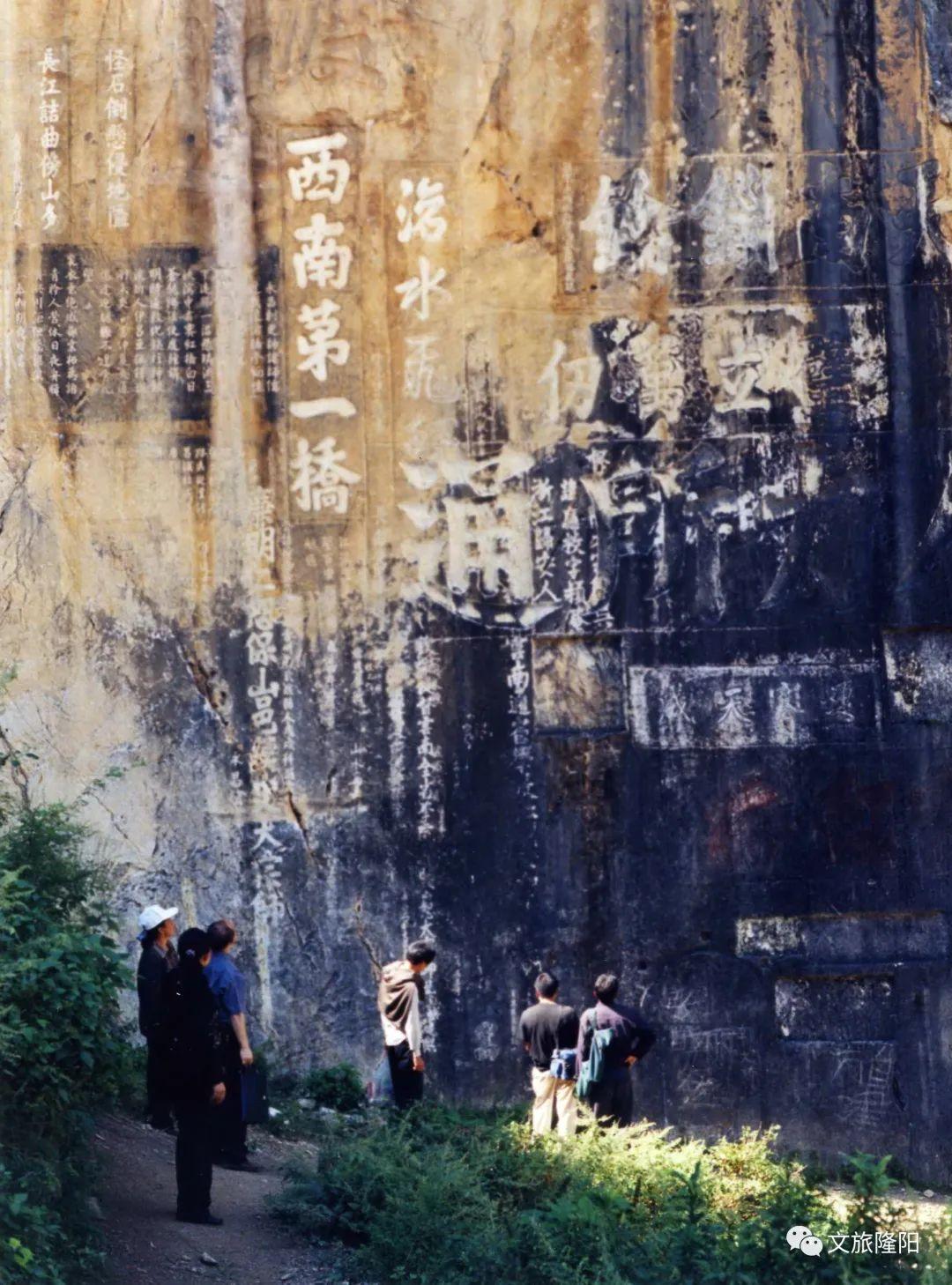
Ancient rock carvings at the Lancang Ferry
Lancang-Ferry Bridge
By Zhang Han
Mountain ranges around the Ailao Kingdom snake;
Countless cliffs and vales the gale in pines make.
Stone colonies are actually left by the Han prime minister;
Iron pillars can perhaps remind us of the Tang royal adviser.
Jade Horse in fiery sun is overlooked by the bridge soaring;
White Dragon in purple mist is floated by the river roaring.
The bridge is as perilous as Magpie Bridge or Fish Weir;
Its top can even the Fantong Palace at Mt. Kunlun near.
Culture ABCs:
a.The poet Zhang Han (1479-1565), native to southwest Yunnan’s Baoshan city, was a successful candidate in the imperial examinations at the provincial level during the reign of emperor Zhengde in the Ming Dynasty. Lack of interest in an official career in the north, he returned to Yunnan and indulged himself in poems. Zhang Han is a close friend of Yang Shen, whose was living in exile in the province.
b.This poem praises grandeur of the Lancang-Ferry bridge and the magnificent landscape of the Lancang River section that lies between west Yunnan’s Dali and Baoshan. The eight-line poem can be divided into two stanzas. The first stanza (Line 1-4) tells the historical realities of the Lancang riverside areas, and the second stanza (Line 5-8) depicts the poet’s romantist imagination on the ferry bridge as an engineering feast. In the Ming Dynasty, the iron suspension bridge at the ferry was the decisive facility on the Southern Silk Road that linked southwest China to south-southeast Asia. Today, the facility has been replaced by modern railway bridges, highway bridges and international cargo ships, making it much easier for Yunnan to connect with the neighboring countries.
c. Centering around west Yunnan's Baoshan city, the 哀牢/Ailao Kingdom in Line 1 existed roughly from the 5th century BC to 69 AD, when it was incorporated into the Han Dynasty. Ailao was the name of the tribal head who first forged ties with the Han Court. The Ailao people were good at riding elephants, and they are said to be related to the later Nanzhao tribes in west Yunnan's Dali, as well as to the Dai-Thai peoples who migrated into Laos, Thailand, north Myanmar and east India. Now, Ailao is better known as a scenic mountain range in Yunnan.
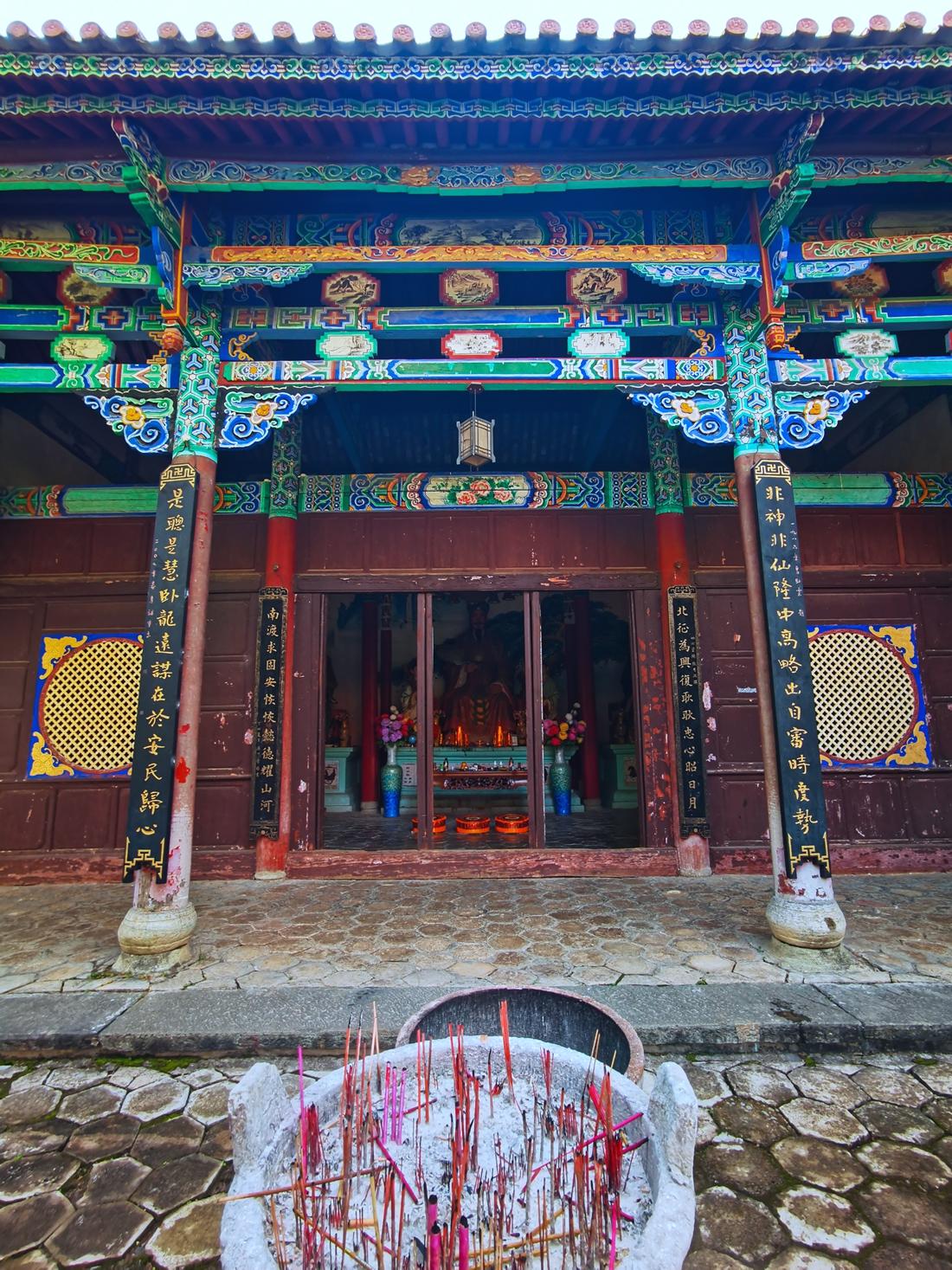
The temple is built up in Baoshan city's Taibao park in honor of Zhuge Liang.
d.汉诸葛/hàn zhū gé in Line 3 refers to Zhuge Liang, the Imperial Chancellor of the kingdom of Shu Han, one of the Three Kingdoms of ancient China (220-280). During his Southern Campaign, also known as the War of Pacification in Nanzhong in 225, Zhuge led his army to Yunnan, resulting in countless stories and legends about him across the province. Today, a temple has been built up in Baoshan city in honor of Zhuge Liang.
e.唐鄂公/táng è gōng in Line 4 refers to Tang Jiuzheng, the imperial superviser of the Tang Dynasty. When the Nanzhao Kingdom joined hands with Tibetan regime in fighting against the Tang Dynasty, Jiuzheng led an expedition to Dali to pacify the alliance in 707 AD, and he set up an iron column near the Erhai Lake to record his feast.
f. 碧马/bì mǎ in Line 5 refers to the mountains of Golden Horse and Jade Rooster in central Yunnan’s Kunming city. As a Yunnan native, the poet once traveled to Kunming to stay with his friend Yang Shen, so he was familiar with the landscapes here.
g. Literally translated as the White Dragon, 白龙/bái long in Line 6 is an allusion of good luck and prosperity in ancient Chinese legends. The dragon is related to the west direction, and in the novel Journey to the West it assumes the form of a white horse, contributing a lot in the scripture-acquiring pilgrimage.
h. In Line 7, 鱼梁/yú liáng refers to the Fish-shaped Weir on the Han River section in central China’s Hubei province, and the weir is said to be where Pang De, the peer of Zhuge Liang in the Three Kingdom period, lived as a hermit. 鹊架/què jià means the Magpie Bridge, an allusion of the Cowherd and Weaving Maid legend. In the story, the lovers can only meet on the magpie bridge in the Milky Way once a year.
i. 樊桐宫/fán tóng gōng in Line 8 refers to a legendary Taoist palace resided by immortals in the Kunlun Mountains in northwest China.
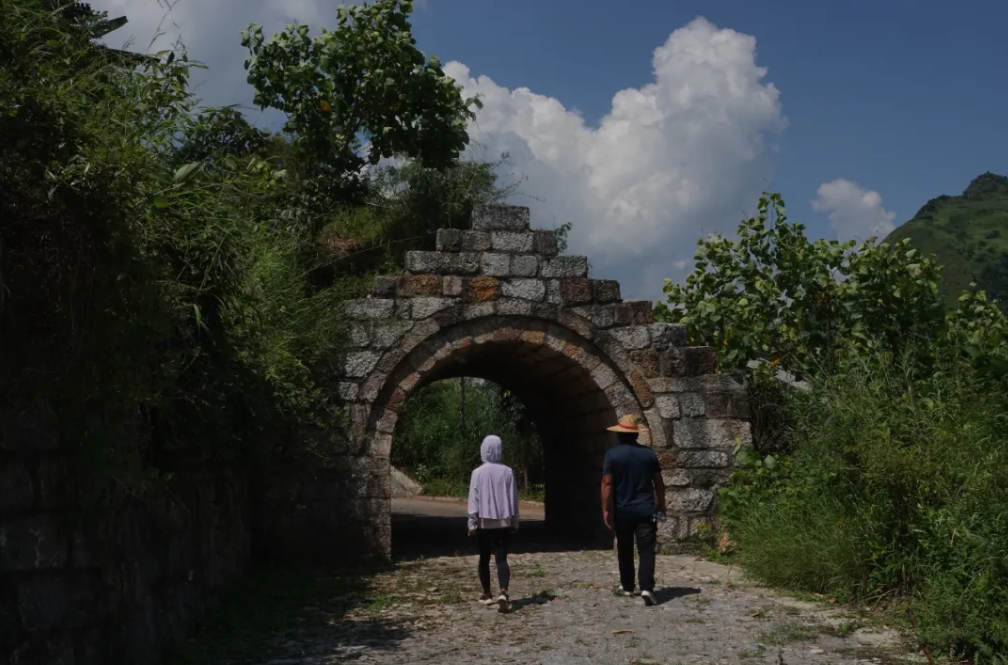
A stone settlement at the Lancang Ferry
III
xiǎo dù lán jīn
晓渡兰津
yuán wén diǎn
袁文典
bái yún shēn hù jì hóng qiáo
白云深护霁虹桥,
xiǎo qì líng kōng shì yù piāo
晓气凌空势欲飘。
xíng kè wèi jīng fēng àn dù
行客未经风暗度,
jiāng shēng tiě suǒ hù tuī qiāo
江声铁锁互推敲。
Crossing Lancang Ferry at Dawn
By Yuan Wendian
White clouds heavily guard the Rainbow Bridge;
It seems to be floating in the soaring morning air.
The wind slips through the bridge before the traveler;
The river sounds and the iron chains echo each other.
Culture ABCs:
a. The poet Yuan Wendian was native to west Yunnan’s Baoshan city. He once served as an education official in southeast Yunnan’s Wenshan prefecture, during Emperor Qianlong’s reign (1736-1796) in the Qing Dynasty. The poem tells west Yunnan’s frontier landscape in four fluent lines.
b. 霁虹桥/Rainbow Bridge in Line 1 is another name of the Lancang-Ferry Bridge in Poem 2.
c. Literally, 铁锁/tiě suǒ in Line 4 means iron locks, but here it refers to iron chains on the bridge.
Chinese sources: The books of Yunnan in Ancient Poems and Selected Yunnan Poems and Lyrics in Past Dynasties; Photo sources: Yunnan Daily and Baoshan Cultural Tourism on WeChat; Trans-editing by Wang Shixue